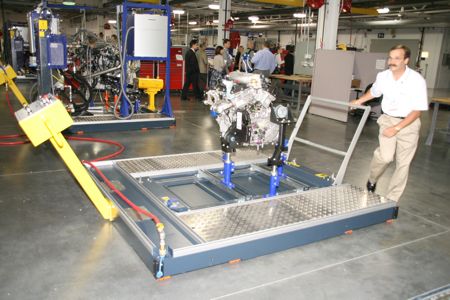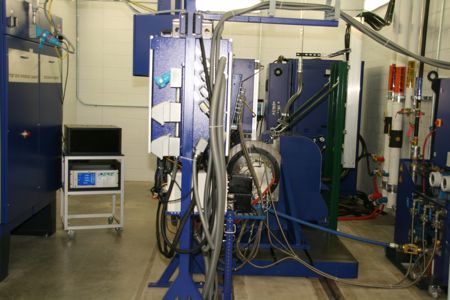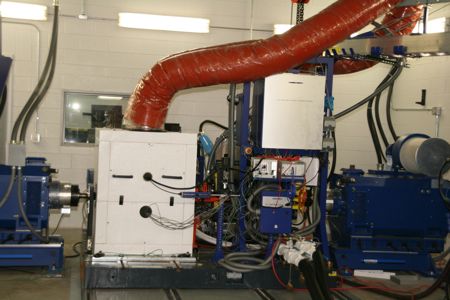Click above for high-res gallery of GM's new powertrain facility
General Motors dedicated its new Powertrain Engineering Development Center in Pontiac, MI on Friday. On hand were CEO Rick Wagoner, Powertrain EVP Tom Stephens and the usual array of elected officials trumpeting their involvement in making the new facility happen. Prior to the speech making and pushing of the ceremonial start-up button, we got a tour of the new 450,000 square foot facility that GM proclaims as the largest, most advanced powertrain development center in the world.
VP of powertrain engineering Dan Hancock explained that the center will be responsible for developing the systems that comprise GM's advanced propulsion strategy. GM is consolidating powertrain development operations from four facilities in Southeast Michigan at this new Pontiac location. When the 1,200 relocating staff have moved in there will be 4,300 staff on site. GM is using new systems being implemented to move forward with its Road to Lab to Math (RLM) strategy that will help reduce engineering development costs. The center will lead development of all manner of future GM powertrains from new gas and diesel engines to hybrid systems and the E-Flex system that will power the Volt. Read on to learn about some of the new systems GM is putting in place to help improve its powertrains.
General Motors dedicated its new Powertrain Engineering Development Center in Pontiac, MI on Friday. On hand were CEO Rick Wagoner, Powertrain EVP Tom Stephens and the usual array of elected officials trumpeting their involvement in making the new facility happen. Prior to the speech making and pushing of the ceremonial start-up button, we got a tour of the new 450,000 square foot facility that GM proclaims as the largest, most advanced powertrain development center in the world.
VP of powertrain engineering Dan Hancock explained that the center will be responsible for developing the systems that comprise GM's advanced propulsion strategy. GM is consolidating powertrain development operations from four facilities in Southeast Michigan at this new Pontiac location. When the 1,200 relocating staff have moved in there will be 4,300 staff on site. GM is using new systems being implemented to move forward with its Road to Lab to Math (RLM) strategy that will help reduce engineering development costs. The center will lead development of all manner of future GM powertrains from new gas and diesel engines to hybrid systems and the E-Flex system that will power the Volt. Read on to learn about some of the new systems GM is putting in place to help improve its powertrains.
[Source: General Motors]

The core of the idea behind the new facility is RLM. By moving more of the development upstream in the process from vehicle testing to lab work and simulation, more designs can be tested faster and at lower cost. Building prototype parts and vehicles is extremely expensive. The more testing that can be done before putting parts on a vehicle, the greater the savings. The problem is the test environment. If it is a math simulation of lab testing, it has to emulate the real world environment for the test results to be valid. GM has made huge efforts in this area to improve the accuracy of its simulation models.
It has also improved the lab testing process itself. The center now has 120 test cells for testing everything from engines to transmissions and motors for both hybrid and electric vehicles. Maximizing the use of the test cells is a major priority. Traditional dynamometer test cells have a bed plate with mounting brackets and dynamometer. The engines to be tested then have to be installed and all the associated plumbing and electrical hookups configured. In an old fashioned cell, installation of a new engine can take up to 24 hours making testing different configurations a time consuming process.

GM has worked with powertrain engineering consultant AVL to develop a palletized system that can be assembled outside the cell with a fully dressed engine or transmission and control system. When the component is ready to test, a hovercraft type cart is used to move the pallet into a cell in a process that can be done easily by one technician. A standardized quick connect system has been developed to connect fuel, electrical power, exhaust and the dyno. The whole process can be completed in under 20 minutes and requires no tools. Other companies have done pallet type systems for dyno labs but change-overs still take several hours. All the fueled test cells are equipped to run gas, diesel and flex fuel engines. GM and AVL have had the pallet system running in proof of concept form for two years at AVL's facility in Ann Arbor and have experienced no issues with the quick connect systems.
Twenty of the cells are designed specifically to test motors for both hybrid drive and electric drive vehicles. The drive system for the upcoming Chevy Volt, for instance, is being developed in the new facility.

One aspect of the new center that is unique in the industry for powertrain development is the tilt test stands. Two stands, one for engines and one for transmissions will be capable of tilting the test components by up to 53 degrees and produce up to 1.3g of acceleration. The stands use hydraulic struts in a manner similar to aircraft flight simulators or the full vehicle simulator pioneered by Mercedes-Benz. The advantage is that engineers will be able to test fluid flow management in extreme conditions such as hard cornering in a Corvette. Traditionally such dynamic behavior has only be testable in the vehicle where it tends to be hard to reproduce. The tilt stands will be able to replicate any condition the engineers want time after time.
The improved simulation models also allow the engineers to create procedures for automating calibrations of engines and transmissions. The initial calibrations aren't perfect but they provide a much closer starting point before heading out into an actual car to finalize them.

Another aspect of vehicle testing that can be greatly reduced is cold and hot testing. Traditionally engineers have had to go to extreme locations like far northern Canada and Death Valley to test vehicles for cold and hot start conditions. They now have climatic test containers and temperature soak rooms for climatic testing. After assembling a test pallet, an insulated box is placed over the test unit and the whole thing is moved into a soak chamber. Once the unit has been soaked down to -40 degrees (or whatever temperature) the quick install capability is used to get the whole thing into a cell for testing. Engineers can control the temperature, humidity and pressure in the cells to simulate all manner of conditions including high altitude (or low for Death Valley). This won't completely eliminate vehicle testing, but it will reduce the need and a lot of the expense.

All those engines being tested also mean a lot of exhaust gases. The center has four regenerative thermal oxidizers that process all of the exhaust eliminating 96 percent of the carbon monoxide and unburned hydrocarbons. Energy from the dynamometers is also being recaptured and used to provide 15 percent of the electrical energy needs of the center.
GM has been able to eliminate 10 weeks from the powertrain development process so far with these new test methods and facilities. One of a prototype's three test phases has actually been completely eliminated. GM has also implemented a common operating system throughout its powertrain development facilities worldwide, allowing data to be shared instantly and test loads to be shared and run 24 hours a day. Hancock estimates the company will have saved a cumulative $200 million by the end of 2008 alone, which is money this American company could sorely use elsewhere.

GM'S NEW GLOBAL POWERTRAIN ENGINEERING DEVELOPMENT CENTER WILL HELP CUSTOMERS SAVE FUEL AND REDUCE EMISSIONS
GM saves money, too: more than $200 million by year's end
Chevrolet Volt's drive unit, motors, power electronics and engine will be tested in the new center
Time for some test procedures will be reduced from 24 hours to 20 minutes
PONTIAC, Mich. – Time equals money, and in keeping with this formula, General Motors today opened a brand-new, state-of-the-art global Powertrain Engineering Development Center that will bring advanced, fuel-saving powertrains to market faster and at less cost by reducing 10 weeks from its powertrain development process.
Combined with other global powertrain development and testing efficiencies under way, including aggressive use of math modeling, GM will have saved more than $200 million cumulatively in development and testing costs by the end of this year.
The 450,000-square-foot facility is the largest and most technically advanced powertrain development center in the world. It's where GM will develop and test the Chevrolet Volt's electric drive unit, motors, power electronics and engine; electric motors for fuel cell and hybrid powertrains; and other advanced gasoline, biofuel and clean diesel engines and transmissions. It is the model for 11 additional GM powertrain laboratories around the globe.
"This new global engineering development center significantly strengthens our ability to design, develop and test our products, as well as offer customers an unprecedented choice of advanced powertrains that save fuel, reduce emissions and deliver great performance," said Tom Stephens, executive vice president, GM Powertrain and Global Quality.
"The center will use a common, global laboratory operating system that will enable round-the-clock development with the flexibility to develop many new powertrain technologies."
The Powertrain Engineering Development Center is adjacent to GM Powertrain's Global Headquarters and brings together 1,200 employees from engineering centers currently located in Ypsilanti, Wixom, Romulus and Warren. Combined, the Powertrain Engineering Development Center and GM Powertrain Global Headquarters will employ approximately 4,300.
Faster, better, and at less cost
The facility features two test wings with 120 flexible dynamometer test cells and more than 100 powertrain component test stands. Advanced test automation, environmental control and data analysis capabilities are expected to improve GM's powertrain efficiency by 50 percent on many lab procedures. For example, computer-controlled dynamometer testing and math modeling – including 68 new laboratory calibration procedures – allow GM to reduce the number of expensive vehicle road tests required to validate a system.
By shifting some road testing to the laboratory, along with using computer math simulation tools, engineers who previously developed calibrations with expensive vehicles can now perform this work with greater accuracy, repeatability and, ultimately, quality.
The efficiencies realized at the Powertrain Engineering Development Center build on GM Powertrain's ongoing global Road-to-Lab-to-Math (RLM) initiative, which transitions testing that was historically conducted in a vehicle to advanced lab and computer-aided analysis. Engineers use computer-aided engineering software to run simulated and controlled laboratory tests of powertrains and components to optimize fuel economy, emissions and performance. This reduces the amount of physical vehicle tests. Vehicle testing is used later in development to confirm that designs meet the powertrain program targets.
"We've reduced the time necessary to create our initial calibrations, saving us on average 10 weeks of critical development time in our programs," said Stephens. "We expect these savings to increase as we shift more work into the new lab.
"When you combine the savings in North America with all of the global Road-to-Lab-to-Math initiatives within GM Powertrain, we expect to have saved more than $200 million cumulatively in development and testing costs by the end of this year."
From 24 hours to 20 minutes
A quick-change pallet system allows all components for a test to be pre-assembled on a pallet in a test prep area prior to installation in the test cell. The pallet is simply air-floated into the test cell, docked and connected for the test. With little effort, a single technician can move up to four tons of equipment via compressed air that forces the pallet off the floor, much like a hovercraft. In fact, changeover procedures that previously required up to 24 hours can now be accomplished in 20 minutes.
Advanced Dynomometer Testing
The center's advanced computer-controlled test cells include non-fueled and fueled capabilities, as well as the flexibility to test all powertrain configurations, including front-, rear- and all-wheel drive. The fueled engine tests use a variety of automotive fuels – gasoline, diesel and ethanol. The non-fueled tests use electricity to power a motor that simulates an engine or transmission.
Here's a look at the dynamometers and testing equipment:
Non-fueled spin cells are electrically driven and used to test components and systems. New "loaded" dynamometers allow the simulation of real-world driving performance earlier in the development cycle, as the components or systems can be tested with a realistic load without being installed in a test vehicle.
Powertrain cells are high-dynamic, loaded dynos used to test fueled, running engines and engine/transmission/hybrid combinations. These cells test a wide range of operating characteristics, including durability, 0-60-mph acceleration and performance, shift quality, reliability, varying speeds, towing, climbing steep grades and wide-open-throttle driving. Many of these cells are capable of controlling ambient air temperature and fluids to simulate extreme hot (+60 C) to cold (-40 C) climates.
Engine cells are high-dynamic loaded dynos that simulate road conditions and test gas, diesel and biofuel running engines over a wide range of engine characteristics including calibration, durability, performance and emissions. Many of these cells are capable of controlling ambient air temperature and fluids to simulate extreme hot (+60 C) to cold (-40 C) climates.
Engine and transmission tilt test stands simulate the effects of various vehicle inputs – such as acceleration, braking and cornering – on the transmission and engine oil sump and fluid management system without the use of a vehicle or test track. This enables quicker transmission development. The tilt stands can simulate up to 1.3-g loads, enabling the simulation of everything from extreme lateral forces of a Corvette on a racetrack to the angles of a four-wheel-drive vehicle climbing a mountain pass – up to 53 degrees of tilt in all directions.
Cold testing simulates cold-weather testing in-house and year-round, making product development cycles independent of seasonal conditions and geographic locations. Testing can simulate extreme cold-weather conditions of up to -40 C.
Heavy-Duty Engine Emission Certification cells are capable of meeting both EPA and international heavy-duty certification and development test cycles. The cells meet the new certification capabilities of the EPA's latest testing standards and regulated emissions levels for model years 2010 and beyond.
System uses recycled energy; captures 96 percent or more CO emissions
The new facility is also using technology to recycle energy to operate the facility and reduce emissions. Delivering all of the power utilities used in the center's test cells is a large, on-site central energy plant. General Motors manages the facility through a co-operative management system with DTE Energy. Up to 15 percent of the power for this facility is recycled energy generated in-house.
The development center also uses four regenerative thermal oxidizers (RTOs) to significantly reduce the amount of exhaust gas emissions. The RTOs capture the test-engine exhaust gases, cleaning the carbon monoxide and unburned hydrocarbon emissions before they're released to the environment. The RTOs reduce at least 96 percent of CO emissions.
General Motors Corp. (NYSE: GM), the world's largest automaker, has been the annual global industry sales leader for 77 years. Founded in 1908, GM today employs about 266,000 people around the world. With global headquarters in Detroit, GM manufactures its cars and trucks in 35 countries. In 2007, nearly 9.37 million GM cars and trucks were sold globally under the following brands: Buick, Cadillac, Chevrolet, GMC, GM Daewoo, Holden, HUMMER, Opel, Pontiac, Saab, Saturn, Vauxhall and Wuling. GM's OnStar subsidiary is the industry leader in vehicle safety, security and information services. More information on GM can be found at www.gm.com.


Sign in to post
Please sign in to leave a comment.
Continue